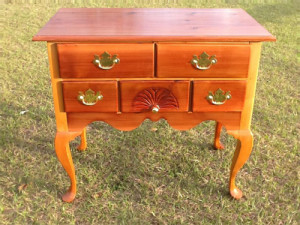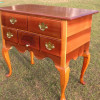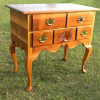- Dressing Tables (Lowboys)
- Lowboy
Lowboy
Member Gallery
This piece was built entirely by hand using, as much as possible, the same tools and techniques used by a Colonial cabinetmaker in 1750. This is my first large piece done entirely by hand, so I choose an inexpensive and easy to plane/shape material for the primary and secondary wood--Western Red Cedar--the same material that many people use on the side of a house or on a deck, certainly not a material used by a colonial cabinetmaker. Each piece was hand planed/thicknessed from the rough stock. No power tools of any kind were used in the creation of this piece. The hand planes used are wooden planes. All cuts were made with hand saws. All shaping was done with homemade turning saws, planes, files, etc. Since they didn't have sandpaper in 1750's Colonial America, all final 'leveling' was first done with card scrapers and then Pumice/water (if necessary). The case and drawers are dovetailed. The legs are removable as was sometimes common with the Newport makers and are not a part of the case. All drawer hardware is non-lacquered. Everything is assembled with hot hide glue. The finish starts with multiple coats of boiled linseed oil, and then a home made Sandarac varnish (shellac was not used on finer pieces until much later in the century). The final coat is a heated and rubbed-in coat of natural beeswax. Much influence came from Jeffrey Greene's book ,American Furniture of the 18th Century. Other influences came from: Period Furniture Details by Lonnie Bird and Working Drawings of Colonial Furniture by Frederick J. Bryant.



